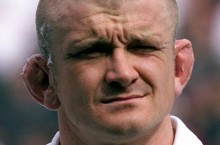
You may not know this but the first reported wearing of headgear, called a ‘scrum cap’ in England, was at Christ’s College Finchley in London during the 19th century.
The scrum cap was a thin cloth helmet with padding over the ears and a chin strap to hold it in place. This early form of headgear was intended to protect the ears of the player only and to prevent that nasty inflammation of the ‘shell likes’, cauliflower ears.
Latterly, the scrum cap developed into something like a sophisticated version of a leather flying cap in the early 20th century.
These days, former England prop Graham Rowntree is the most prominent advertisement for the benefits of wearing headgear. His ears would win the best cauliflower growing prize at any local fete and top the Borg’s pumpkin by a country mile.
Medically, cauliflower ears occur when repeated knocks cause a blood clot or fluid to accumulate in the ear tissue. As a result of this the cartilage separates and dies which leads to this swollen and deformed condition. As Rowntree has found out, it’s permanent.
Actually, Christ’s College Finchley’s other claim to rugby fame is that graduate C.J. Monro introduced rugby to NZ in 1870 (he formed the Nelson Rugby Club) and associate R.W. Shepstone-Giddy did the same in South Africa.
Leather headgear reached it’s peak in the 1950’s and 60’s when it was common for tough international forwards like Wilson Whineray, Pinetree Meads and Tiny Naude to wear a scrum cap.

It fell out of favour during the long-haired period of the 1970’s when it was deemed to be uncool and daggy.
However, with the development of more efficient, flexible and tougher materials (like impact resistant high-density foam), some bright spark developed a technically superior protective cocoon that encased the head and it took off again in the 90’s.
A far cry from Che Guevara’s accoutrement (photo, top right). Yes, this really is Ernesto Guevara de la Serna Lynch. He was of Irish and Basque stock and a rugby player of note.
He was reportedly a tough inside centre in the manner of Felipe Contepomi.
Unfortunately he turned into a brutal and sadistic killer in later life, much like George Bush, another celebrated rugby player. He also, unusually for a back in

those days (the 1940’s), wore a scrum-cap so that his matinee idol good looks weren’t ruined.
Guevara studied at university in Buenos Aires to become a doctor and played for three rugby clubs: Atalaya Polo Club, Ypora and San Isidro (who were recently in Queensland).
He also founded a rugby magazine, called Tackle (mmmmm). He wrote under his own name or a nom-de-plume, Juan Cote Chang-Cho, which is apparently a play on one of his nicknames: the Pig (obviously a misnomer because he was a woosey back).
Later in 1951, Guevara set off to discover the world with his rugby mate and fellow medic Alberto Granado on a 1939 Norton 500cc motorcycle. These days Granado (81) is patron of the Cuban Rugby Union, which was created in 1996 and Guevara is fortunately a former rugby player.

Headgear has developed into something more sophisticated these days. Not just to protect from cauliflower ears but from head injuries in general and prevents cuts, bruising and pain.
It also provides a security blanket for mums who are frightened little Johnny will get his brains knocked out while playing this ‘brutal’ game. Without it, they’d all be playing soccer…..
Headgear is strictly defined by Regulation 12 of the IRB as being made of soft, thin materials and not more than 1cm thick. Stiff materials, such as plastics, are expressly forbidden. Likewise in shoulder padding.
Speaking of protective padding, mouth-guards were used in boxing for many years but only came into vogue in rugby during the 1970’s after a Canadian pediatric dentist developed a thermo-plastic model to prevent injuries to kids playing hockey.
Canadian pediatric dentist developed a thermo-plastic model to prevent injuries to kids playing hockey.
All headgear worn in rugby union must carry an IRB approval logo. Whilst they may prevent some cuts and abrasions, headgear hasn’t been totally accepted as a reducer of concussive injury.
However, a recent American rugby collegiate study begged to differ and indicated that when headgear was worn there was about a three-to-one chance that you’re not likely to be concussed than if you didn’t wear it.

So, there’s pros and cons to wearing headgear. Although well-ventilated these days they still get pretty hot, uncomfortable and restrictive (around the strap), especially in warmer climes and it can muffle your hearing a bit.
Using tape to protect your ears has also been around for many years and is an accepted way of preventing cauliflower ears.
Scrum caps have come a long way since the initial cloth version emerged a century or two ago.
What will be interesting is how they develop in the future and whether the trend to risk averse outcomes continues so that headgear will one day become a compulsory component of playing the game.
Sources: RFU, NZRFU, The Daily Telegraph, Rugby Relics, Rugby Football History, Study – Efficacy of Rugby Headgear in Attenuating Repetitive Linear Impact Forces, Wikipedia,

